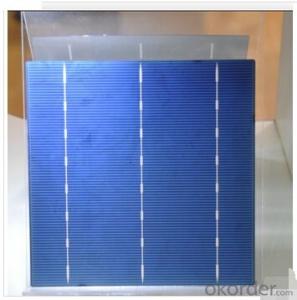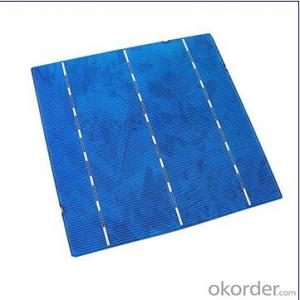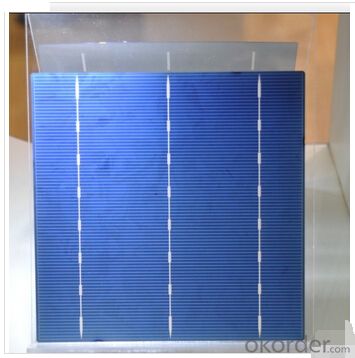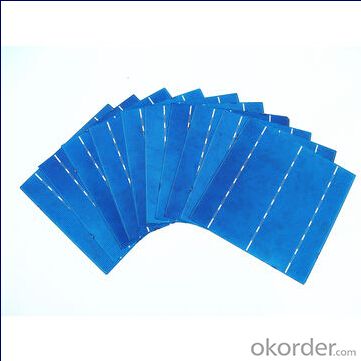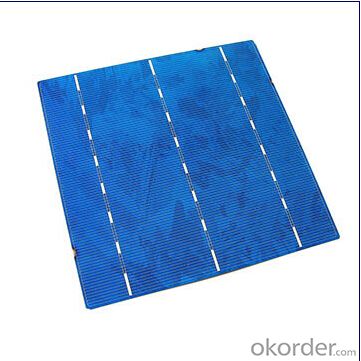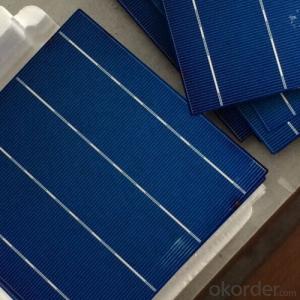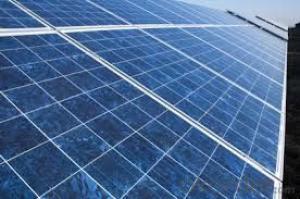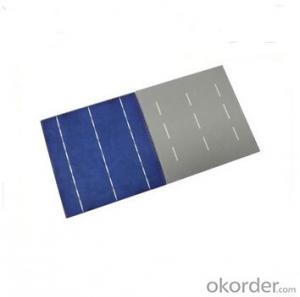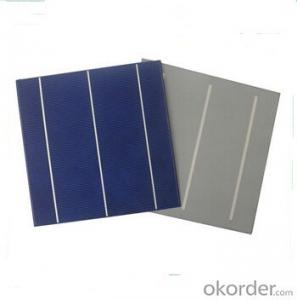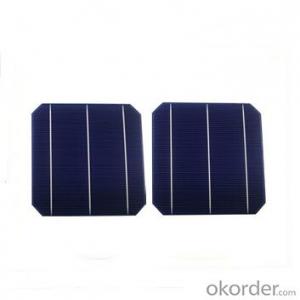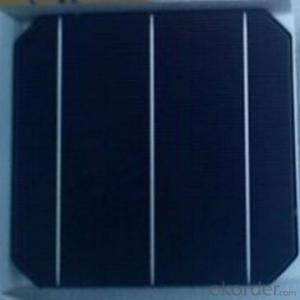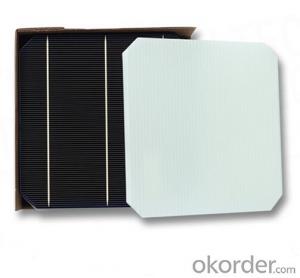Solar Cells Australia - Polycrystalline Solar Cells Series- 17.8%
- Loading Port:
- Shanghai
- Payment Terms:
- TT OR LC
- Min Order Qty:
- 1000 pc
- Supply Capability:
- 100000 pc/month
OKorder Service Pledge
OKorder Financial Service
You Might Also Like
Solar Cells:
Solar cells is made by solar wafer, it has three categories of solar cell right now, monocrystalline polycrystalline and thin film,These cells are entirely based around the concept PN junction, which is the critical part of solar module, it is the part that can convert the light energy into electricity, the thickness is from 180um to 200um, with even busbars to conduct electricity, textured cell can decrease diffuse reflection; they are often electrically connected and encapsulated as a module. Photovoltaic modules often have a sheet of glass on the front (sun up) side, allowing light to pass while protecting semiconductor wafers from abrasion and impact due to wind-driven debris, rain, hail, etc. Solar cells are also usually connected in series in modules, creating an additive voltage. Connecting cells in parallel will yield a higher current;With high quality and stable quality. Our Cells can greatly improve the performance of Solar Modules.
Features:
1. High conversion efficiencies resulting in superior power output performance.
2. Outstanding power output even in low light or high temperature conditions
3. Optimized design for ease of soldering and lamination
4. Long-term stability, reliability and performance
5. Low breakage rate
6. Color uniformity
Solar Cells Advantage:
1. Tire-1 Solar Cells’ Manufacturer Quality Guarantee. With a complete and sophisticated quality government system, our Quality Management have arrived world’s leading place. Customer can receive Tire-1 Cells Maker’s Quality Standard Products.
2. Trusted Warranty. We can supply trusted after-sales service to our customer. If our cells are found not in conformity to the specification of manufacturer, or should the inspected quantity found in shortage, or should the packing found damaged, the buyer has the right to claim to the seller. The claim, if any, should be presented to seller within 30 days after cargo's arrival date to the port, together with related inspection report and photos issued and provided by a reputable independent surveyor such as SGS.
3. World’s Leading Manufacturer Equipment. We imported the newest and leading production equipment from abroad. Advanced equipment can guarantee the stable quality of cells. Auto production line can also save labor cost which will further cut our production cost.
4. Bulk supply: With the production capacity of 500MW, we can produce large quantity every month. This can satisfy most customer requirement.
Specifications:
Efficiency | Power | Max Power Current | Min Power Current | Max Power Voltage | Short Circuit Current | Open Circuit Voltage |
Eff(%) | Ppm(W) | Ipm(A) | Ipm(A) | Vpm(V) | Isc(A) | Voc(V) |
18.20-18.39 | 4.43 | 8.53 | 8.36 | 0.532 | 8.82 | 0.633 |
18.00-18.19 | 4.38 | 8.40 | 8.26 | 0.529 | 8.78 | 0.630 |
17.80-17.99 | 4.33 | 8.33 | 8.20 | 0.527 | 8.74 | 0.629 |
17.60-17.79 | 4.28 | 8.29 | 8.08 | 0.524 | 8.70 | 0.628 |
17.40-17.59 | 4.23 | 8.26 | 8.03 | 0.522 | 8.66 | 0.625 |
17.20-17.39 | 4.19 | 8.22 | 7.99 | 0.520 | 8.61 | 0.623 |
Product | Polycrystalline silicon solar cell | |||||
Dimension | 156mm×156mm ±0.5mm | |||||
Thickness(Si) | 200µm±15µm | |||||
Front | Blue silicon nitride antireflection coatings 1.4mm silver busbar 3BB | |||||
Back | Full-surface aluminum back-surface field 2.6mm silver continuous or discrete soldering p | |||||
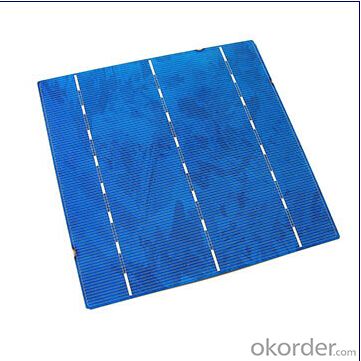
FAQ
We have organized several common questions for our clients,may help you sincerely:
①What price for each watt?
It depends on the efficiency of the solar cell, quantity, delivery date and payment terms.
②How long can we receive the product after purchase?
In the purchase of product within three working days, We will arrange the factory delivery as soon as possible. The pecific time of receiving is related to the state and position of customers.Commonly 7 to 10 working days can be served.
③Can you provide the peripheral products of the solar panels, such as the battery, controller, and inverter? If so, can you tell me how do they match each other?
Yes, we can, we have two companies for solar region, one is CNBM International, the other is CNBM engineering Co.
We can provide you not only the solar module but also the off grid solar system, we can also provide you service with on grid plant.
④What is your warranty of solar cell?
Our product can promise lower than 0.3% open box crack, we support claim after opening the box if it has crackm color difference or sth, the buyer should give pictures immediately, we can not accept the claim after the solar cell has assembled to solar panel.
• Timeliness of delivery
• ⑤How do you pack your products?
We have rich experience on how to pack the solar cell to make sure the safety on shipment, we could use wooden box or pallet as buyer's preference.
- Q: Can solar cells be used for space applications?
- Yes, solar cells can be used for space applications. Solar cells are commonly used in space missions to convert sunlight into electricity, providing power to satellites, space probes, and even manned spacecraft. The abundance of sunlight in space makes solar cells an ideal and reliable source of energy for various space applications.
- Q: Can solar cells be used for powering remote weather stations?
- Yes, solar cells can be used for powering remote weather stations. Solar cells convert sunlight into electricity, providing a sustainable and reliable source of power for remote locations where access to the grid may be limited or non-existent. This makes solar cells an ideal solution for weather stations that require continuous power supply in remote areas.
- Q: Can solar cells be used for powering hospitals?
- Yes, solar cells can be used to power hospitals. Solar energy can be harnessed through solar panels or solar cells, and these can generate electricity to meet the power needs of hospitals. By utilizing solar power, hospitals can reduce their reliance on traditional energy sources, lower their operating costs, and contribute to a cleaner and more sustainable environment. However, the feasibility of using solar cells for powering hospitals depends on factors such as the hospital's energy demand, available space for solar panels, and the region's sunlight availability.
- Q: Can solar cells be used in agricultural settings?
- Yes, solar cells can be used in agricultural settings. They can be used to power irrigation systems, electric fences, and other equipment used in farming. Additionally, solar panels can be installed on agricultural buildings or land to generate electricity, reducing the reliance on grid power.
- Q: How do solar cells perform in areas with high humidity and saltwater exposure?
- Solar cells can still perform well in areas with high humidity and saltwater exposure, although their efficiency may be slightly reduced. The moisture in the air and the saltwater can create a thin layer of corrosion on the surface of the solar cells, which can hinder their performance over time. However, advancements in solar cell technology, such as improved coatings and materials, have made them more resilient to these conditions. Regular cleaning and maintenance can also help mitigate the effects of humidity and saltwater exposure on solar cell performance.
- Q: What is the average lifespan of a solar cell in space?
- The average lifespan of a solar cell in space can vary depending on several factors such as the quality of the materials used, the level of radiation exposure, and the specific mission requirements. However, on average, solar cells in space can last anywhere from 10 to 25 years.
- Q: Can solar cells be used for powering hotels?
- Yes, solar cells can be used for powering hotels. Solar energy is a clean and renewable source of power that can be harnessed through the use of solar cells, also known as photovoltaic panels. These panels convert sunlight into electricity, which can be utilized to power various appliances and systems in hotels. By installing solar panels on rooftops or in open spaces, hotels can reduce their reliance on conventional energy sources, lower their carbon footprint, and potentially save on electricity costs in the long run.
- Q: Is the Solar Power Photovoltaic Cells the same as PV cells modules?
- According to the application needs, solar cells after a certain combination, to achieve a certain rated output power and output voltage of a group of photovoltaic cells, called PV modules
- Q: Can solar cells be used in electric grid stabilization?
- Yes, solar cells can be used in electric grid stabilization. Solar power can contribute to stabilizing the electric grid by providing a consistent and reliable source of renewable energy. The excess energy generated during peak sunlight hours can be stored in batteries or fed back into the grid, helping to balance the supply and demand. Additionally, solar power can reduce the reliance on traditional power plants, thereby reducing the risk of grid instability caused by disruptions in fossil fuel supply or sudden variations in demand.
- Q: What is the impact of snow accumulation on solar cell performance?
- Snow accumulation can significantly reduce the performance of solar cells. The presence of snow on the surface of solar panels prevents sunlight from reaching the cells, thereby reducing their ability to generate electricity. Additionally, the weight of the snow can cause structural damage to the panels and potentially lead to their failure. Therefore, snow accumulation must be cleared promptly to ensure optimal solar cell performance.
Send your message to us
Solar Cells Australia - Polycrystalline Solar Cells Series- 17.8%
- Loading Port:
- Shanghai
- Payment Terms:
- TT OR LC
- Min Order Qty:
- 1000 pc
- Supply Capability:
- 100000 pc/month
OKorder Service Pledge
OKorder Financial Service
Similar products
Hot products
Hot Searches
Related keywords
